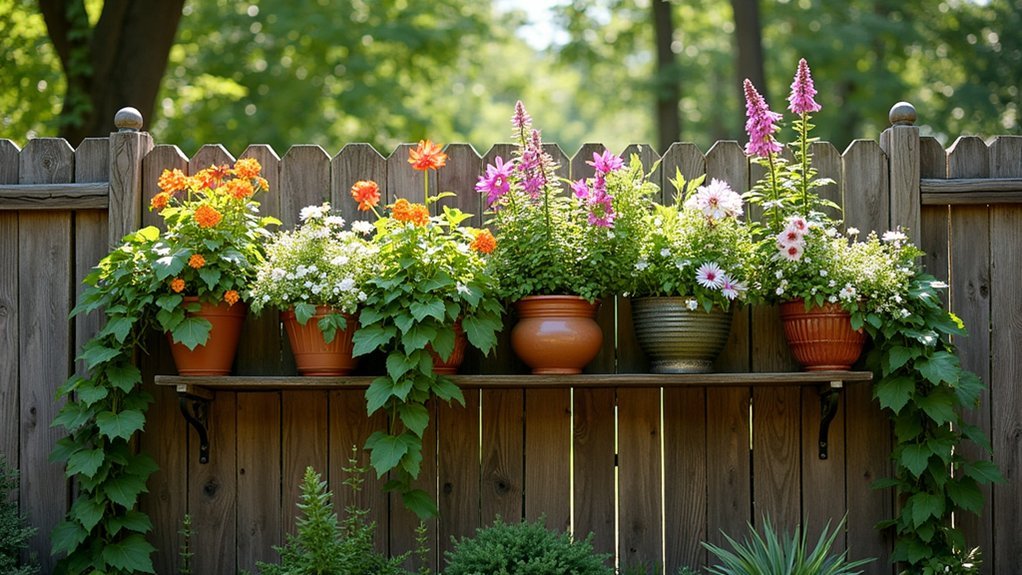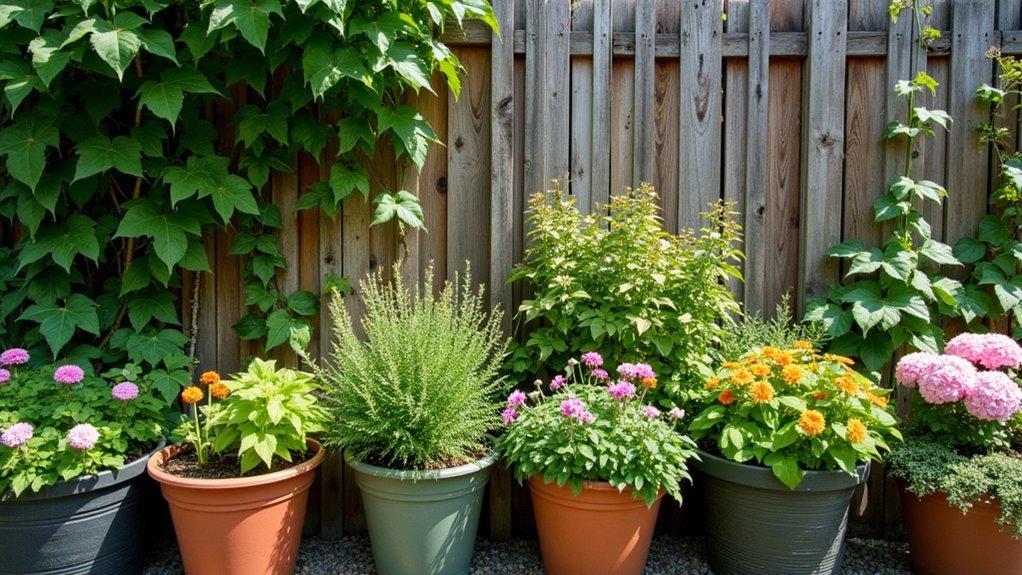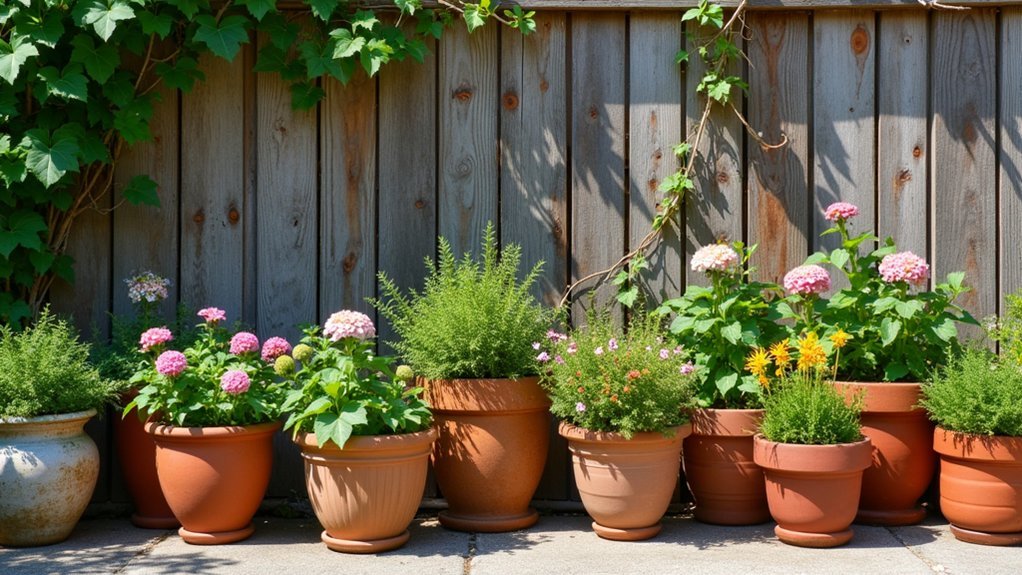Container gardens make perfect fence partners by transforming unused vertical space into growing opportunities while enhancing privacy. You’ll create visual interest through varied heights, textures, and colors that soften rigid fence lines. These portable gardens offer flexibility to rearrange seasonally, improve plant health through better air circulation, and create protective microclimates along fence boundaries. Position taller plants at the back with cascading varieties in front for dimensional appeal. Discover how this dynamic pairing can completely transform your outdoor boundaries.
6 Second-Level Headings for “What Makes Container Gardens Perfect Fence Partners?”

When planning your outdoor space, choosing the right elements to complement your fence can dramatically transform your yard’s appeal and functionality.
Container gardening alongside fences creates a perfect partnership that enhances privacy while adding visual interest to otherwise plain boundaries.
Tall plants like ‘Siam Ruby’ banana or dog fennel in containers provide additional screening above fence lines, creating layers of privacy without permanent modifications. You’ll appreciate the flexibility to rearrange your garden as seasons or preferences change, unlike traditional landscaping.
Strategically grouped containers help define intimate spaces within your yard while maintaining an open feel.
The versatility of container gardening allows you to incorporate flowering annuals and hardy perennials throughout the year, ensuring your fence line remains vibrant regardless of weather conditions or seasonal changes.
Vertical Space Maximization: Turning Boundaries Into Growing Opportunities
Your fence isn’t just a boundary—it’s prime real estate for creating stunning vertical gardens with stacked containers that multiply your growing area.
By mounting tiered planters and suspending hanging pots, you’ll transform flat barriers into multi-dimensional growing spaces that showcase climbing vines and cascading blooms.
These boundary beauty boosters not only maximize your garden’s potential by utilizing vertical space but also create eye-catching displays that elevate the entire aesthetic of your outdoor area.
Stacked Space Solutions
Though garden space may seem limited by fencing boundaries, vertical container gardening transforms these constraints into opportunities. By stacking containers vertically along your fence line, you’ll create a living tapestry that maximizes every inch of available space. Choose tall containers that complement your fence while providing adequate depth for root development.
When planning your vertical garden, consider:
- Grouping plants with similar light and water requirements together on each level to simplify maintenance.
- Incorporating a mix of trailing, upright, and flowering plants to create visual interest and dimension.
- Using lightweight materials for upper containers to prevent stress on lower structures while ensuring proper drainage.
This stacked approach improves air circulation and light exposure, creating healthier plants while transforming ordinary fences into extraordinary garden features that reflect your personal style.
Climbing Plant Potential
Fence boundaries offer untapped vertical gardening potential that container-grown climbing plants can transform into living walls of beauty and function. By placing containers along your fence line, you’re creating perfect launching points for climbers like pole beans and clematis to reach skyward.
Unlike a solid wall of potted plants, climbing varieties maximize your space efficiency by growing up rather than out. You’ll find that installing trellises or supports directly in containers creates an ideal environment for these vigorous growers while maintaining excellent soil drainage and management.
The best part? These plants work quickly, covering unsightly fences with lush greenery and vibrant colors in just one season.
Your containers become strategic partners in this vertical approach, allowing you to position, move, and maintain climbing plants for best coverage and visual impact.
Boundary Beauty Boosters
Beyond climbing varieties, those barren fence lines present extraordinary opportunities for creative container arrangements that transform boundaries into showcases of color and texture.
By strategically positioning containers along fences, you’ll maximize vertical space while creating lush, vibrant boundaries without permanent installations.
- Select tall, fast-growing plants like ornamental grasses or flowering bushes to enhance privacy while establishing dramatic focal points against your fence backdrop.
- Attach vertical planters and hanging containers directly to fences, creating a living wall effect that beautifies previously unused vertical space.
- Incorporate varied heights and textures in your fence-adjacent containers to enhance overall aesthetics, transforming plain boundaries into inviting garden features.
Self-irrigating containers reduce maintenance while ensuring consistent moisture, making it easier to sustain diverse plantings that elevate your outdoor space’s boundary appeal.
Creating Visual Interest Through Height and Texture Variations
While flat, monotonous gardens fade into the background, skillfully varied container arrangements command attention and transform ordinary fences into dynamic backdrops.
You’ll create visual drama by positioning tall specimens like ‘Siam Ruby’ banana or foxglove as centerpieces that draw the eye upward, while shorter plants like coleus fill lower spaces for a layered effect.
Mix containers of different sizes, shapes, and materials for heightened interest.
Try elevating certain pots on cinderblocks to showcase special plants and add vertical dimension.
For texture, pair smooth-leafed snake plants with coarse ornamental grasses to create tactile contrast that adds depth to your display.
This thoughtful manipulation of height and texture turns your fence line from a flat boundary into a vibrant, three-dimensional garden tableau that captivates from every angle.
Softening Rigid Fence Lines With Strategic Container Placement

The rigid geometry of fence lines creates a visual challenge that container gardens can beautifully resolve. When you place containers thoughtfully along your fence, you’ll transform harsh boundaries into inviting garden features that flow naturally with your landscape.
Transform rigid fence lines into flowing garden features by strategically placing container plantings along your boundaries.
- Position containers at varying distances from the fence to create depth and break up straight lines—closer plantings soften the immediate fence edge while further ones draw the eye outward.
- Incorporate cascading plants like Golden Creeping Jenny in elevated containers to create softening waterfalls of foliage that disguise the fence’s hard edges.
- Stagger your container heights and widths to create rhythm along the fence line, using taller plantings where you need more privacy and shorter ones where you want to maintain views.
Privacy Enhancement Through Strategic Plant Selection
When creating a privacy screen, you’ll want to select tall, robust plants like ‘Siam Ruby’ bananas that utilize vertical space while adding visual interest.
Group your containers strategically to form a living fence, mixing heights and textures for a natural-looking barrier that feels less imposing than traditional fencing.
You can maximize privacy by positioning taller specimens at key viewpoints, then filling in with mid-height and cascading plants to create a lush, multi-layered shield that’s both functional and beautiful.
Privacy Plants Guide
Creating effective privacy barriers doesn’t necessarily require permanent structures, as strategic plant selection in container gardens can deliver both seclusion and beauty. When you choose plants for privacy, focus on height, growth rate, and visual density to maximize screening effectiveness.
- Select tall specimens like ‘Siam Ruby’ banana, dog fennel, and ornamental grasses that naturally form visual barriers while maintaining flexibility in your garden design.
- Opt for fast-growing varieties such as Impatiens and Vining Coleus for shaded areas to establish quick privacy without the wait.
- Combine plants with colorful foliage and seasonal blooms like coleus and begonias to create barriers that are both functional and aesthetically pleasing.
Use heavy, stable containers to prevent tipping in windy conditions, and group plants with similar water and light requirements together.
Vertical Space Maximization
Maximizing vertical space transforms ordinary container gardens into effective privacy screens, especially when you strategically layer plants of varying heights.
By selecting specimens that grow tall enough to block unwanted sightlines, you’ll create natural barriers that enhance your outdoor sanctuary without permanent structures.
Arrange containers in a staggered formation, positioning taller plants like ‘Siam Ruby’ banana or dog fennel at the back, with shorter, colorful varieties in front.
Make certain your containers have proper drainage holes to support healthy growth, particularly for fast-growing privacy plants that need ideal conditions.
You’ll appreciate the flexibility of this approach—simply reposition your containers as plants mature or seasons change to maintain perfect visual screening.
For maximum benefit, combine ornamental species with functional herbs or fruit-bearing plants for a privacy solution that’s both beautiful and useful.
Weather Protection and Microclimate Benefits Along Fence Lines

Although often overlooked, the space along your fence line offers a unique opportunity to create protective microclimates through strategic container gardening. Your fence already acts as a windbreak, and when you add containers, you’re amplifying this weather protection effect while creating ideal growing conditions for plants that might struggle elsewhere in your garden.
- Containers positioned along fences benefit from radiant heat, warming plants during cooler weather and effectively extending your growing season.
- The elevated position of containers guarantees superior drainage during heavy rainfall, preventing root rot issues common in ground-level plantings.
- Your fence-container combination creates microclimate benefits by moderating temperature fluctuations—keeping soil warmer in winter and cooler during summer heat waves.
This protective partnership makes fence lines prime real estate for sensitive plants that wouldn’t survive in more exposed garden areas.
Frequently Asked Questions
What Are Two Disadvantages of Container Gardening?
In container gardening, you’ll face more frequent watering needs as pots dry out quickly. You’re also dealing with limited soil volume, which restricts root growth and requires you to fertilize more regularly.
What Is the Best Mulch for Container Gardens?
For your container gardens, you’ll find organic options like shredded bark, wood chips, or straw work best. They retain moisture and improve soil health. Alternatively, decorative stones offer a longer-lasting solution while enhancing visual appeal.
How Do You Layout a Container Garden?
You’ll want to arrange containers in triangular formations for stability. Place taller plants at the back, stagger containers for visual interest, and leave enough space between pots for maintenance. Don’t forget to embrace asymmetry for natural appeal.
Do Container Gardens Need More Water?
Yes, you’ll need to water container gardens more frequently than in-ground plants. The limited soil volume dries out faster, especially in hot weather, requiring daily watering during summer and regular moisture monitoring.
In Summary
You’ve now seen how container gardens transform ordinary fences into dynamic garden features. They maximize your vertical space, add visual texture, and soften harsh lines while providing privacy and protection. By pairing the right containers with your fence, you’ll create a personalized garden boundary that works twice as hard—containing plants while enhancing your outdoor space’s beauty and functionality.





Leave a Reply